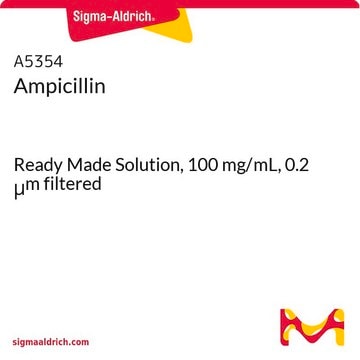The product is stable for nearly 3 years when stored at room temperature. There is no specific requirement to store L2542 at 2-8°C. However, if the container is opened and closed, there is a possibility of contamination through routine use.
L3522
Bouillon LB (Miller)
Highly-referenced nutrient-rich microbial growth powder medium, suitable for regular E.coli culture
Synonyme(s) :
Bouillon Luria, Bouillon LB (Miller)
Sélectionner une taille de conditionnement
Sélectionner une taille de conditionnement
About This Item
Produits recommandés
Qualité
Molecular Biology
for molecular biology
Niveau de qualité
Description
Miller′s Modification, 10 g/L NaCl
Stérilité
non-sterile
Forme
powder
Composition
NaCl, 10 g/L
Tryptone, 10 g/L
Yeast Extract, 5 g/L
pH
6.8-7.2(2.5% solution)
Application(s)
food and beverages
Température de stockage
room temp
Adéquation
nonselective for Escherichia coli
nonselective for coliforms
Description générale
Application
Il convient à la culture non sélective de souches d'E. coli en vue d'un clonage, de la production de plasmides d'ADN ou de la fabrication de protéines recombinantes. Il convient également aux cultures sélectives avec ajout d'antibiotiques adaptés.
Actions biochimiques/physiologiques
Caractéristiques et avantages
- Une transposition facile à plus grande échelle, grâce à de plus gros conditionnements.
- Une alternative économique au format liquide.
- Une formulation standard.
Notes préparatoires
2. Stériliser par autoclavage pendant 15 minutes à 121 °C.
Pour préparer le milieu de Luria, Adams et Ting (également appelé "bouillon LC") : en conditions aseptiques, après autoclavage, ajouter 25 ml de chlorure de calcium 0,1 M stérile.
Reconstitution
Produit(s) apparenté(s)
Code de la classe de stockage
11 - Combustible Solids
Classe de danger pour l'eau (WGK)
WGK 3
Point d'éclair (°F)
Not applicable
Point d'éclair (°C)
Not applicable
Faites votre choix parmi les versions les plus récentes :
Déjà en possession de ce produit ?
Retrouvez la documentation relative aux produits que vous avez récemment achetés dans la Bibliothèque de documents.
Les clients ont également consulté
Articles
Genetic engineering enables large-scale expression and isolation of recombinant proteins for research purposes.
SeqPlex™-I WTA kit amplifies RNA for NGS, enabling genomic studies from limited samples.
Protocoles
General protocols for growth of competent cells in microbial medium.
Contenu apparenté
KOD One™ PCR Master Mix overview for ultra-fast PCR with high specificity, fidelity, and yield
-
What is the recommended duration for using this item after autoclaving, and can it be stored at 4 degrees Celsius for extended or long-term use?
1 answer-
Helpful?
-
-
What is the difference among the LB - Miller products?
1 answer-
LB - Miller is available in many types to suit your needs. The different product formats include powder and liquid form. The powder form is also available with agar for easy LB-agar plate preparation.L2542 (LB Miller liquid)L3522 (LB Miller powder)L3147 (LB Miller powder with agar)
Helpful?
-
-
Will adding magnesium to the culture medium increase cell density?
1 answer-
In microbial broth formulations that do not already contain magnesium, the addition of 10-20 mM MgCl2 or MgSO4 may increase cell densities. You may need to also increase the shaking speed of the incubator.
Helpful?
-
-
What is the Department of Transportation shipping information for this product?
1 answer-
Transportation information can be found in Section 14 of the product's (M)SDS.To access the shipping information for this material, use the link on the product detail page for the product.
Helpful?
-
-
What are the differences among the Luria, Lennox and Miller LB formulations?
1 answer-
LB, (originally termed lysogeny broth) was initially composed of tryptone, yeast extract, NaCl and glucose. Soon after, the glucose was omitted (Miller's version), and later the NaCl content lowered by half (Lennox's version). For some applications, even lower salt is required (Luria's low salt version).
Helpful?
-
-
Which bacterial culture medium is the best choice for my application?
1 answer-
Each of the broths will likely grow E. coli very well, but there are still general guidelines for choosing a broth when you are working without a protocol. Generally:LB - Miller and LB - Lennox are used for E. coli growth and maintanence, DNA plasmid production and protein production. The Lennox formulation has a lower salt content required for some salt-sensitive selection antibiotics.LB - Luria low salt is used for special applications where the E. coli growth or other constraints require the lowest possible salt content.Terrific Broth is used for higher yield protein production and high yield DNA plasmid production, because of the faster growth of the E. coli in this medium.SOB is used for protein production, DNA plasmid production and the generation of high-efficiency competent cells.SOC is used for initial growth of competent cells and the transformation procedure.
Helpful?
-
Active Filters
Notre équipe de scientifiques dispose d'une expérience dans tous les secteurs de la recherche, notamment en sciences de la vie, science des matériaux, synthèse chimique, chromatographie, analyse et dans de nombreux autres domaines..
Contacter notre Service technique














